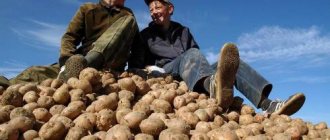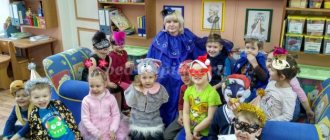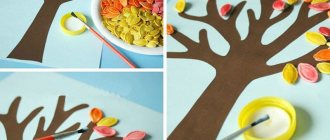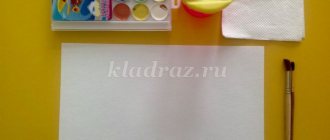Lesson to familiarize children with the world around them “My favorite toys”
Technological map of organizational educational activities in the senior group.
Date: 09.14.2015 Educational area: “Cognition” Section: Familiarization with the world around us. Topic:
“My favorite toys.”
Goal:
to give children an idea about toys.
Tasks:
to continue introducing children to toys, to teach them to correctly name the general concept of “toys,” to introduce them to the purpose of toys and materials.
Develop spatial orientation, development of thinking, fine motor skills, expansion and enrichment of vocabulary. Cultivate a caring attitude towards toys, learn to listen to the teacher’s instructions and complete the proposed tasks. Material:
demonstration pictures of toys, a box of toys made from different materials, handout pictures of toys.
Methodological techniques:
explanation, demonstration, composing objects from cut-out pictures, composing stories for children.
Vocabulary work:
toys.
Bilingual component:
toys-oyynyshyktar
Stages
Teacher's actions
Children's actions
accounting
Motivational and incentive
Circle of greetings:
Who, who rises with the sun?
Who, who lives in this kindergarten? The kids all woke up and smiled at each other. Introducing children into a game situation
The teacher invites the children to guess what will be discussed in class today using cut-out pictures.
Game “Cut Pictures” Each of the pictures is divided into several parts. The teacher invites the children to come to the table and choose any fragment.
They greet each other.
Pictures depicting toys are selected.
They make up a picture from fragments, after which a conclusion is drawn about the topic of the lesson.
Organizational and incentive
Organizationally stimulating
The teacher suggests naming the toys that are in the group and thinking about why these objects are called toys. Asks children to say which toys they like to play with the most and why. Finds out whether children know where toys come from in kindergarten and at home. The teacher explains that toys are made at the toy factory by adults, that the factory has different workshops and toys are made from different materials in each. The teacher shows the children toys and explains that, for example, a ball is made of rubber, a pyramid is made of wood, a lotto is made of cardboard, a bear is made of fabric, which is called plush, toy cars are made of plastic and metal. He says that then an artist or special machines paint them, and they become bright and elegant. Physical exercise “Playing with the ball”
Now we are playing with the ball: we throw it up, we throw it down, we hit the ball off the floor, we roll the ball left and right. Tomorrow we will play with our ball again.
Game "What is what?" The teacher invites the children to go to the table on which there are toys made from different materials. Asks the children what material are these toys made of? He asks you to touch them with your hands and say what material they are made of. An adult demonstrates a sample statement. This horse is made of wood.
The teacher tells the children that toys are not only made from different materials, they can also vary in size, that there are big toys and small ones. Game “Big Little” with a ball The teacher names a large toy and throws the ball to the child, the child catches the ball, names a small toy and throws the ball to the teacher. Ball - ball, Doll - doll, Car - car, Hare - bunny, Bucket - bucket, Pyramid - pyramid, Ship - boat The teacher invites the children to tell them how to handle toys so that they do not break and delight us for a long time. At the end of the lesson, the teacher reads N. Naydenova’s poem “Our Toys.” There are a lot of toys in kindergarten, Our toys are in plain sight: Puss in Boots, long-eared bunnies, And a drum, and balalaikas. Dolls are sitting elegantly in braids, Dolls are looking at hares and bears. We don’t hit or break our toys, we don’t take them away from our comrades. Our toys are in plain sight - We have everything in common in kindergarten.
They listen to the teacher, share knowledge about toys.
Consider toys made from different materials
children try to repeat the movements and imitate actions with the ball.
Listen and complete the task
Children tell what toys are made of: This doll is made of rubber. This machine is made of metal. This cube is made of plastic. This bunny is made of plush. This box is made of cardboard
Called toys
children tell how to care for and treat toys.
Listen to a poem.
Reflexive-corrective
— What did they talk about in class? - What new did you learn? — What did you like most?
Children's answers.
Expected result:
To know:
the purpose of toys, what materials they are made from.
To be able to:
compose a picture from several parts, answer questions, complete the proposed tasks.
Technological map of organizational educational activities in the senior group. Date: 12/28/2015 Educational area: “Cognition” Section: Familiarization with the world around us. Topic:
“Our house and our furniture.”
Goal:
repeat the general concept of “Furniture” and its purpose.
Objectives:
to continue introducing children to pieces of furniture, to teach them to correctly name the general concept of “furniture”, to introduce them to the purpose of furniture and materials, to develop spatial orientation, the development of thinking, fine motor skills, to expand and enrich the vocabulary, to cultivate a caring attitude towards pieces of furniture, furniture care, to teach listen to the teacher’s instructions and complete the assigned tasks.
Material:
demonstration pictures depicting furniture, pieces of toy furniture, flannelgraph strips, sticks for laying out furniture, cardboard, handout pictures of furniture.
Methodological techniques:
explanation, demonstration, asking riddles, writing stories for children.
Vocabulary work:
furniture.
Bilingual component:
furniture
Stages
Teacher actions
Children's actions
accounting
Motivational incentive
Circle of greetings:
Who, who rises with the sun? Who, who lives in this kindergarten? The kids all woke up and smiled at each other. - Turn around and look, we have guests today. Now the one who will answer the question will sit down: - What is at the top? At the bottom? Who is standing to your right or left? Etc.
They greet each other.
Answer questions and sit on chairs
Organizationally stimulating
Organizationally stimulating
Behind the screen there are clue objects (toy table, chair, bed). Makes riddles: Everywhere you will find this object, you can work on it, relax on it More comfortable than on a stool You can’t help but know its name! Look, this object has a back, legs and a seat. And I'm waiting for an answer from you. What is my poem about? B) On the legs in a dream Vanyatka will doze off so sweetly that he doesn’t want to get up. What kind of thing am I? There are four legs under the roof. There is soup and spoons on the roof. As they are guessed, the items are put on the display table. Points to guessed objects, generalizes the concepts of furniture. - Tell me in one word what it is? Asks each child to pronounce the word “furniture” correctly. Organizes a conversation about furniture: - What other furniture do you know?
— Tell me what kind of furniture is in our group? - Once again, what did you just name? As the children name the furniture, the teacher puts up demonstration pictures on the easel. Conducts a game: “What is it and what is it for.” - What is this? — What does the table have, what parts? - What is the table for?
The parts of a chair, bed, and wardrobe are called similarly. Finger gymnastics:
Chair
Legs, back and seat - here’s a chair for your surprise (2 times, first with the right hand, then with the left hand)
Table
The table has four legs;
The lid is like a palm on top. Physical education lesson
We play the harmonica We clap our hands loudly We shake our heads slightly We raise our hands up.
Our hands clap clap. Our legs are top top We lower our palms down We rest, we relax The teacher talks about where and how furniture is made: - Furniture is made at a furniture factory. — What is furniture made of? (made of wood) - What kind of furniture is made of wood? (wooden) - It is made by a carpenter, then the furniture is taken from the factory to special stores. Which? (furniture stores) And they sell to people there. Questions for children:
Who makes the furniture? —Where is furniture made? - What are they made of? -Where are they being delivered?
- Now we will try to lay out pieces of furniture from sticks. -We will lay them out from left to right, everyone’s backs are straight and beautiful. Lays out the table on the flannelgraph. The chair and bed are laid out in the same way.
Listen to riddles and guess them.
(
chair)
(bed)
(table)
Answer the questions: (furniture) Individual repetitions of children. Participate in the conversation Answer questions (wardrobe, bedside table, stool, etc.) (wardrobe, table - tables, chairs, etc.) (furniture) Examine object pictures
Name objects and talk about their purpose. (table) (4 legs, table top)
children try to repeat movements and words clearly.
Perform movements according to the text
Listen to a story about furniture making
Answer the teacher's questions.
children look, guess the object, then each independently lays out the image on their table
tsu.
Reflexively corrective
— What did they talk about in class? - What new did you learn? — What did you like most?
Children's answers.
Expected result:
Know:
about the purpose of furniture
Be able to:
guess riddles about pieces of furniture, answer questions, complete suggested tasks.
Technological map of organizational and educational activities Date: 21.01. 2016 Educational area:
Society
Section:
Familiarization with the environment + Ecology
Topic:
“Amazing forest.”
Purpose Wed.
gr: introduce the inhabitants of the forest.
The purpose of the senior group:
Consolidation of knowledge about the inhabitants of the forest.
Objectives:
- Clarify ideas about the life of animals and birds in the forest.
Develop cognitive activity and mental abilities. To instill in children a caring attitude towards nature and proper behavior in the forest. Vocabulary work:
forest dwellers
Methodological techniques:
Examination of illustrations of animals, drawing up cut-out pictures, guessing riddles, conversation, games.
Equipment:
environmental signs, plot pictures of the forest, subject pictures on the topic “Forest inhabitants”.
Bilingual component:
les-orman. Stages of activity
Teacher's actions
Children's activities
Accounting
Motivational and incentive
Circle of joy “Bouquet of wishes” The teacher invites the children, passing the flower to each other, to say words of wishes for joint activities. - Today we will go on an amazing journey. But during the journey you will act as a guide, and I will be the traveler. But now the cut-out pictures will tell us where we will go.
Children stand in a circle and say wishes to each other.
Listen to the teacher, get acquainted with the topic of the lesson.
Organizational search
Educator: Shows illustrations depicting winter landscapes. Reads a poem. The frost came out into the open spaces for a walk, White patterns in the braids of the birches. Snowy paths, bare bushes Snowflakes fall quietly from above. (E. Avdienko). What time of year is this poem written about? Winter brought strict order to its domains. Everything about her is tidy and sparkling white. We will go with you into a forest full of fairy tales and miracles, We will observe together, we will notice the magic of everything. The teacher draws the children's attention to a picture of trees: - Please name the trees you see?
She asks a riddle: Red-haired, fluffy, Very cunning, Sneaks quietly, Anyone who doesn’t have time will fall into her clutches. Educator: What do you know about the fox?
- Well done! Now let's take a little rest. Let's take a break at the edge of the forest. Fizminutka
. Let's show each other how a fox runs.
Educator: Try to guess another riddle. Into the farthest black forest, where the fir trees are dense, Sometimes angry, angry ones run in... Educator: What do you know about the wolf, about his life, habits?
Educator: And who is afraid of the wolf and the fox in the forest? Educator: Why? Educator: Yes, there are birds that make nests in trees, and there are those that make nests in fields or bushes. The wolf and the fox love to feast on bird eggs. Winter is a very difficult time of year for birds, especially if it is frosty and snowy. Birds wake up with the sun and look for food all day long. A hungry bird on a cold night can die. Relaxation exercise “Warm the bird.” Let's imagine that you find a freezing bird.
Finger gymnastics. Come, birds! I'll give the lard to the titmouse. I'll prepare some crumbs and some bread. These crumbs are for the pigeons, These crumbs are for the sparrows. Jackdaws and crows, Eat pasta!
Conducts the “Yes-No” game. I really enjoyed our walk through the winter forest.
Children look at winter landscapes
Listen to a poem
Children answer questions: - about winter
Children look at a picture of trees, answer the teacher’s questions. We see birch, pine, spruce. Guess the riddle: Fox
Children talk about the fox: This is a wild animal, lives in the forest, has red fur. It feeds on hares and mice, so it is a predatory animal. She is also very cunning and careful.
They make careful, insinuating movements.
Guess the riddle: Wolves.
This is a predator that lives in the forest. Hunts small and sometimes large animals. Strikes fear into the entire forest. Squirrels, hares, birds. The fox sneaks up unnoticed, and the wolf is a very strong animal. It is very difficult to escape from them.
(Expression of surprise, disappointment).
Children fold their palms, imitating that they are holding a bird, breathe on it to warm it, press it to their chest, stroke its head, and release it into the wild.
(Happy facial expression).
First - “calling” movements of the fingers, then “cutting” movements of one palm on the other. Fingers with a pinch - “crumb the bread”, rub the pads of your fingers against each other. Extend your right hand forward with your palm open, and do the same with your left hand. Rub palm against palm, “rolling pasta out of bread.” Answer questions.
Reflexive-corrective
— What did they talk about in class? - What new did you learn? — What did you like most?
Children answer the teacher's questions
Expected result:
Know:
about who lives in the forest.
Be able to:
apply acquired knowledge in various situations.




